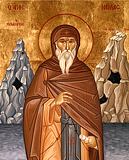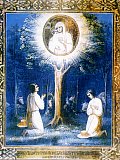

| Previous day | Next day |
| Old Style
May 7
|
Thursday |
New Style
May 20
|
| 3rd Week after Pascha. Tone 2. | No fast.
|
![]() Commemoration of the Apparition of the Sign of the Precious Cross over Jerusalem in a.d. 351 (351).
Commemoration of the Apparition of the Sign of the Precious Cross over Jerusalem in a.d. 351 (351). ![]() Martyr Acacius the Centurion, at Byzantium (303).
Martyr Acacius the Centurion, at Byzantium (303).
St. John of Zedazeni in Georgia, and 12 disciples: Sts. Shio of Mgvime, David of Gareji, Anthony of Martqopi, Thaddeus of Urbnisi (or Stepantsminda), Stephen of Khirsa, Isidore of Samtavisi, Michael of Ulumbo, Pyrrhus of Breta, Zeno of Iqalto, Jesse (Ise) of Tsilkani, Joseph of Alaverdi, and Abibus of Nekressi (6th c.). Repose of St. Nilus, founder of Sora Skete (Belozersk) (1508). Uncovering of the relics of St. Nilus the Myrrh-gusher, of Mt. Athos (1815). Synaxis of the Saints of St. Panteleimon Monastery (Mt. Athos).
'Lyubech' (11th c.) and 'Zhirovits' (1470) Icons of the Most Holy Theotokos.
St. Lydia of Philippi (1st c.). Uncovering of the relics of St. Euthymius the Great (473). St. Domitianus, bishop of Maastricht (560). St. John of Beverley, bishop of York (721). King Bagrat III of Georgia (1014). New Martyr Pachomius the Russian, of Usaki near Philadelphia (1730). St. John the Confessor, of Psycha on the Bosphorus (ca. 825).
Repose of Monk Nicholas (Boris in schema) of Valaam and Pskov (1969).
Thoughts for Each Day of the Year
According to the Daily Church Readings from the Word of God
By St. Theophan the Recluse

039
Thursday. [Acts 8:26–39; John 6:40–44]
Saint Philip asks the eunich: understandest thou what thou readest? He answered: how can I, except some man should guide me? (Acts 8:31). How often those who read the word of God and writings of the fathers experience the same thing! What is read is beyond our comprehension; the mind cannot heed or grasp it, as if it were something foreign to it, about topics of an unknown realm. This is why an interpreter is needed, who is familiar with the meaning of the words. Saint Philip had the same spirit as the one which brought those prophecies, and so it was not difficult for him to interpret what the eunuch found hard to understand. Thus it is for us now: we must find a person who stands on such a level of life and knowledge as is touched upon by the scripture which is difficult for us, and he will interpret it without difficulty, because each level has its own spiritual view. He who stands on a lower level does not see all that he who stands on the higher sees, and can only guess about it. If it happens that the scriptures which are incomprehensible for us touch upon subjects of the higher level, but the interpreter met by us stands on the lower, then he cannot explain it as he should, and will apply everything to his own outlooks, and it will remain for us as dark as before. One must marvel at how people take on interpreting topics of Scripture while being totally foreign to the realm to which these subjects belong. And for them it does not come out as it should; nor do they fail to get puffed up over their own interpretations.
Articles
 Martyr Acacius the Centurion at ByzantiumSaint Acacius lived in the third century, and was an officer in the Roman army during the time of Maximian. |
 1500 years of Georgian Monasticism—St. Shio-Mgvime MonasteryAndrei GermanSt. Shio is among the Great 13 Assyrian Fathers, who came at the end of the fifth century from Antioch to preach Christ. |
 St. Jesse, Bishop of Tsilkani in GeorgiaSaint Jesse of Tsilkani arrived in Georgia in the 6th century with the other Syrian fathers and companions of Saint John of Zedazeni. |
 Icon of the Mother of God of LubechThe Lubech Icon of the Mother of God received its name from the city of Lubech, on the outskirts of Chernigov. |
 Icon of the Mother of God of ZhirovichiThe Zhirovichi Icon of the Mother of God appeared in the year 1470 in the vicinity of Zhirovichi on the Grodnensk frontier. |













